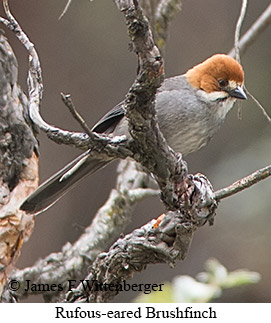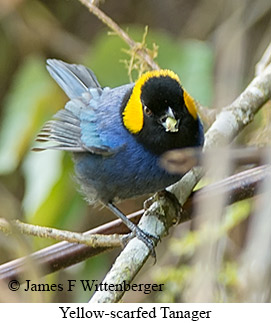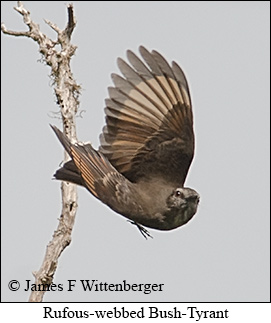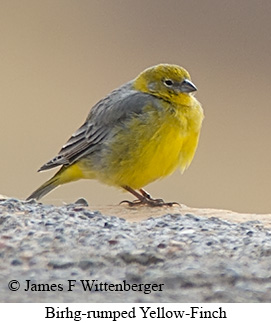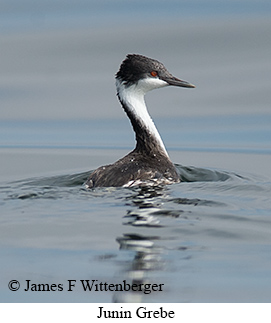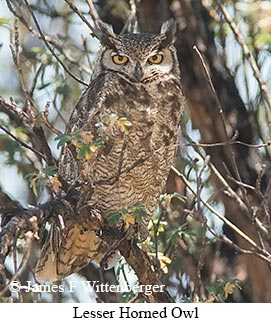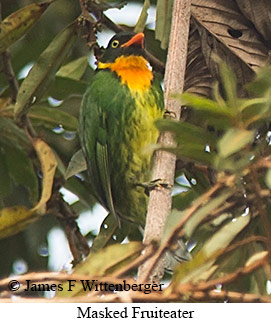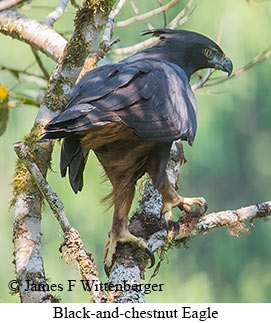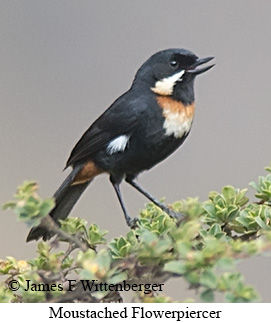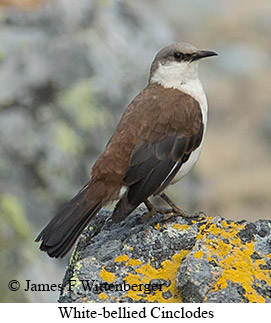PERU BIRDING TRIP REPORT

TRIP REPORT
PERU
| Start: | 08/12/2023 |
| End: | 08/28/2023 |
| Duration: | 17 days |
| #Species: | 398 |
| #Endemics: | 73 |
| #Heard Only: | 17 |
2023 Central Peru Birding Tour
TOUR DESCRIPTION
The central Andes of Peru is less visited by birding tours but offers a good variety of species not possible in the highlands north of Cusco, along Manu Road, or in northern Peru. Our tour to central Peru was intended to take advantage and see as many of these specialties as we could. Because this region is not on the usual birding tour circuit, accommodations were mostly in moderately priced hotels meant for the general public with a few exceptions where we stayed in quite basic accommodations catering to birders. We had good weather throughout the tour, with only a single rain squall which occurred during our transfer to Satipo. Maybe the weather was too good, as bird activity tends to be less on sunny days and we missed a number of species we had hoped to see.
We arrived in Lima the evening of August 12, 2023 for an overnight stay. Next day (day 2) our tour began in earnest with a drive north to Lima to visit the dry arid area of Lomas de Lachay. The site we visited is a flat plain with very sparse vegetation. We had good views of all our key target species, namely Least Seedsnipe. Coastal Miner, Grayish Miner, Spot-billed Ground-Tyrant, and Band-tailed Sierra-Finch. We also saw Spot-billed Pigeon, Burrowing Owl, and Slender-billed Miner there. We then proceeded to Paraiso Lagoon, a saltwater coastal site, where we saw Chilean Flamingo, White-tufted Grebe, Great Grebe, Plumbeous Rail, Plumbeous Rail, Red-fronted Coot, Black-faced Ibis, and a variety of other wetland birds and shorebirds. A couple people also had quick views of a Blackish Rail. From there we continued north to the coastal beach area at Albufera where we were surprised to see a Peruvian Diving-Petrel quite near the shore. We also picked up
On day 3 we drove into Huaracan National Park all the way to the lake at the end of the road, stopping at several sites enroute. The steep cliffs in this park are quite spectacular and scenic. Some birders hike the Llanganuco Trail, which is a quite strenuous proposition at this altitude. We visited parts of the trail but mostly birded along the road. The elevation of the lake is 3850m (12,631 ft). Target species seen in the park were Rufous-eared Brushfinch and Plain-tailed Warbling-Finch, and Paramo Seedeater. We also saw Black-tailed Trainbearer, Green-tailed Trainbearer, Black Metaltail, Shining Sunbeam, Cream-winged Cinclodes, White-winged Cinclodes, Creamy-crested Spinetail, Baron's subspecies of Line-cheeked Spinetail, Red-crested Cotinga, Cinereous Ground-Tyrant, Peruvian Meadowlark, Black-crested Warbler, Rusty Flowerpiercer, Plushcap, Tit-like Dacnis, Plumbeous Sierra Finch, and Ash-breasted Sierra Finch. We failed to find the very rare White-cheeked Cotinga and other target species such as Ancash Tapaculo, Tawny Tit-Spinetail, Ash-breasted Tit-Tyrant, or Piura Chat-Tyrant. On the way down the mountain we had a flat tire, which we learned in town could not be repaired. Our driver was also not able to purchase a replacement tire for several days due to lack of availability, so we were driving without a spare on bad roads for the next several days. We had planned to spend more time in the park and stay in Yungay, but due to road construction we decided to drive to Huaraz that afternoon to reduce drive time the following day.
On day 4 we had a long drive from Huaraz to Huanuco. This drive typically takes around 5 hours, but we encountered heavy road construction nearly the entire distance, which greatly prolonged the drive often on unpaved roads. We stopped at Lake Conocoches enroute, where we saw a few species not seen on our previous visit, namely Puna Teal, Andean Teal, Streak-throated Canastero, Cordilleran Canastero, and Rufous-naped Ground-Tyrant. Although we left Huaraz at 7:25am, we didn't arrive in Huanuco until 7:35pm despite spending only an hour at Lake Conocoches. Upon arrival we encountered very heavy traffic due to a festival happening near the main road. We were going to say at a moderately priced hotel but due to lack of sufficient rooms we stayed at the much nicer Grand Hotel Huanuco.
On day 5 we departed after breakfast for the Carpish Tunnel area. The road winds up through the mountains and is slow going due to the many slow-moving trucks that can only be passed on occasional straighter sections of the road. Thus, we didn't arrive at the tunnel until 9:05am. We birded up the dirt road that begins at the far end of the tunnel and leads up to some fincas that cultivate the steep slopes of the mountain valley just below. Immediately after arrival, we encountered a nice mixed flock that included our only sighting of the endemic Brown-flanked Tanager. Also in the flock were Pearled Treerunner, Pale-legged Warbler, Spectacled Redstart, Superciliared Hemispingus, White-capped Tanager, Masked Flowerpiercer, and Plushcap. Shortly thereafter we had brief views of Tshudi's Tapaculo and good views of two Yellow-scarfed Tanagers. Other birds seen during the day included Rufous-capped Thornbill, Tyrian Metaltail, Violet-throated Starfrontlet, Yungas Pygmy-Owl, Gray-breasted Mountain-Toucan, Rufous Spinetail, Barred Fruiteater, White-winged Becard, White-tailed Tyrannulet, White-banded Tyrannulet, Tawny-rumped Tyrannulet, Rufous-webbed Bush-Tyrant, Rufous-breasted Chat-Tyrant, Brown-backed Chat-Tyrant, Peruvian Wren, Slaty Brushfinch, Bay-crowned Brushfinch, Citrine Warbler, Rufous-crested Tanager, Black-capped Hemispingus, Pardusco, Blue-capped Tanager, Lacrimose Mountain Tanager, Drab Hemispingus, and Gray-hooded Bush Tanager.
We devoted all of day 6 to Bosque Unchog. This high elevation site is home to many interesting species. The elevation ranges from 3660-4100m (12,007-13,451ft). We departed our hotel at 5:00am and spent 2 hours driving a long, winding, dirt road up to Unchog, which is nothing more than a place to park and a sign. There we ate a box breakfast before setting off on a trail that goes up and down through open scrub, grassland, and stunted forest. The main target species there are Bay-vented Cotinga, Pardusco, Rufous-browed Hemispingus, and Golden-backed Mountain Tanager. Only myself and the guide saw the cotinga, which was in the stunted forest and right at the point where we were turning around to hike back. My two participants had already begun hiking back up the trail and missed it. We failed to see the Pardusco, which is commonly present in mixed flocks, but we had seen it the previous day. Unfortunately, we also failed to find our other two target species. Our guide said he only sees the Golden-backed Tanager about 30% of the time. I'm left wondering if maybe we might have seen it if only we had hiked farther down the trail from the steep downslope where we turned around. At the time, it seemed too much to go farther down the mountain than we already were. Notable birds we did see were Purple-backed Thornbill, Blue-mantled Thornbill, Coppery Metaltail, Neblina Tapaculo, Puna Tapaculo (identified by our guide as being there even though it's range is supposed to be only farther south according to eBird), White-browed Spinetail, Red-crested Cotinga, Red-rumped Bush-Tyrant, Rufous-breasted Chat-Tyrant, Brown-backed Chat-Tyrant, and Scarlet-bellied Mountain Tanager.
On day 7 we returned to the Carpish Tunnel area in the morning, this time leaving earlier and stopping at a caf‚ for breakfast. Thus we arrived at 7:35 and began birding about 8:00am. The only new birds we saw this visit were Golden-headed Quetzal, Montane Woodcreeper, Unstreaked Tit-Tyrant, Mountain Wren, and Buff-breasted Mountain Tanager. We then drove back to Huanuco and spent the afternoon driving to Junin.
We spent the morning of day 8 birding around Lake Junin. This high elevation lake is located at 4082m (13,395ft) and surrounded by scrub grassland and rocky plains. We left our hotel at 6:00am, joined up with a local guide who was most helpful in finding all our target birds, and began birding about 6:35am. It was quite cold as well as well as a bit hard to breathe at this altitude. Our first stop was a marshy area where we had several rather quick views of the Junin Rail, a tiny secretive rail split from the notoriously hard to see Black Rail. At the same site we also saw Buff-breasted Earthcreeper, Black-billed Shrike-Tyrant, and Bright-rumped Yellow-Finch. We then drove to the boat launch area where we embarked on a boat trip to the center of the lake in a small motor boat. Enroute we had good views of Ornate Tinamou along the road. The only way to see the flightless Junin Grebe is to go out by boat into the center of the lake, which is what we did. We had great views of several of them as well as Andean Goose, Puna Teal, White-tufted Grebe, Silvery Grebe, Andean Gull, and various other species. Back on land we had good views of Common Miner, White-winged Cinclodes, and Black Siskin before driving down the road to a stakeout of a roosting Barn Owl. We then drove back the way we came with birding at several sites enroute. We stopped at another stakeout to see a roosting Lesser Horned Owl. We saw several more Ornate Tinamous. Other key species we saw were Spot-winged Pigeon, Black-breasted Hillstar, Puna Snipe, Junin Canastero, and Canyon Canastero. On our way back to town we had our second flat tire. Since we had yet to find a replacement for our first flat, we were out of spares. In addition, it was a Sunday so all the tire shops were closed for the day. Our guide arranged for someone to drive us back to our hotel and with some effort found someone able to fix our flat. This situation was disconcerting for all of us, but our driver had yet been able to find a place to buy replacement tires so we had to make due with no spare for a while longer. We finally left Junin at 3:30pm to make the 4-hour drive to Villa Rica. Enroute we saw several vicuñas in the grasslands not far from the road. Once again we arrived at our hotel later than we would have liked.
We spent the morning of day 9 birding along the road through the Shollet Forest. Bosque Shollet is home to Bay Antpitta and Junin Antpitta as well as several tapaculos, all of which are very difficult to see due to the dense understory of the forest. We failed to see any of those. Another target species was Black-winged Parrot, which only our guide saw as they flew rapidly by. Birds we did see included Spot-winged Pigeon, White Hawk, Masked Trogon, Bar-bellied Woodpecker, Streak-headed Antbird, Chestnut-winged Foliage-gleaner, Streak-necked Flycatcher, Inca Flycatcher, Olivaceous Flatbill, Yellow Tyrannulet, Peruvian Tyrannulet, White-eared Solitaire, Tricolored Brushfinch, Oleaginous Hemispingus, Yellow-throated Tanager, Fawn-breasted Tanager, Blue-and-black Tanager, Beryl-spanged Tanager, Capped Conebill, and Bluish Flowerpiercer.
After lunch we drove to Ulcumano Lodge, arriving at 2:40pm. This is a very pleasant lodge with six canopy towers linked by suspension bridges, and a large tract of good forest. However, it is not often visited by birders due to its out-of-the-way location. For this reason the lodge does not maintain any hummingbird feeders. We spent the remainder of the afternoon birding a trail to the canopy towers and in the tallest of the canopy towers. Birds we saw included Sickle-winged Guan, Green-fronted Lancebill, Lesser Violetear, Rufous-booted Racket-tail (female), a quite distant Chestnut-crested Cotinga (a good reason to visit the lodge), Smoke-colored Pewee, Lemon-chested Greenlet, Andean Solitaire, and Flame-faced Tanager.
We spent all of day 10 birding the limited trails and the back roads around Ucumayo Lodge. Birds seen this day included Speckled Chachalaca, Swallow-tailed Nightjar (seen shortly before dusk along the entrance road), Speckled Hummingbird, White-bellied Woodstar, Red-throated Caracara, Montane Foliage-gleaner, Buff-browed Foliage-gleaner, Jet Manakin (an unexpected sighting by the guide only when the bird flew very fast through the forest along the road), Masked Fruiteater, Scale-created Pygmy-Tyrant, Fulvous-breasted Flatbill, Black-capped Tyrannulet, Rufous-eared Brushfinch, Blue-winged Mountain Tanager, Silvery Tanager, Beryl-spangled Tanager, Flame-faced Tanager, and Gray-hooded Bush Tanager.
We spent the morning of day 11 birding the road near Ulcumano Lodge before transferring in the afternoon to the Satipo area. New birds we saw along the "main" dirt road near the lodge were Emerald-bellied Puffleg, White-bellied Hummingbird, a soaring Black Hawk-Eagle, Chestnut-tipped Toucanet, Streaked Xenops, Azara's Spinetail, Rufous-tailed Tyrant, and Sooty-headed Tyrannulet. We then drove to Satipo, encountering our only rain of the tour, a localized squall as we approached town. We arrived in Satipo after a 4 hour drive and stayed at a hotel in town this night.
We departed early on day 12 to drive up a long, winding, dirt road from Satipo to the small village of Calabaza where we stayed the next two nights. The road up to the village goes through mostly agricultural areas with not much forest, but nevertheless offers some birding. Birds seen on the way up included Andean Guan, Chestnut-collared Swift, Lemon-throated Barbet, Chestnut-eared Aracari, Lafresnaye's Piculet, Yellow-tufted Woodpecker, Crimson-crested Woodpecker, Blue-headed Parrot, White-eyed Parakeet, Masked Tityra, Black-capped Becard, Yellow-bellied Elaenia, Yellow-breasted Flycatcher, White-collared Jay, Violaceous Jay, Olivaceous Siskin, Magpie Tanager, Silver-beaked Tanager, Yellow-bellied Tanager, Swallow Tanager, Moustached Flowerpiercer, Black-throated Flowerpiercer, Plumbeous Sierra Finch, and Dull-colored Grassquit. One of our participants had been hoping throughout the tour to see Black-and-chestnut Hawk-Eagle, a rather rare raptor that is hit and miss. Not long before we reached Calabaza, we spotted a large black bird perched low on a tree limb not far off the road. It turned out to be exactly that, a Black-and-chesnut Hawk-Eagle. We had great views from the car and plenty of time to take photos before in flew. After lunch at a restaurant in town, we birded the upper Satipo Road, which goes through better forest. Birds of note seen in the afternoon were Wire-crested Thorntail, Sword-billed Hummingbird, Sapphire-spangled Emerald, Blue-banded Toucanet, Gray-browed Brushfinch, Slaty Brushfinch, and Hooded Mountain Tanager. Our accommodations in Calabaza are best described as sub-basic: a converted concrete building owned by the community with interior wafer-board walls, no doors in the door openings, and a single bathroom for all 6 rooms that featured a shower that only the guide and driver were interested in using. It's the only available accommodation in the area and staying there is better than driving 2-hours each way from Satipo to reach the birding sites of the upper Satipo Road, not to mention another hour and a half to reach the Andamarca Valley.
On day 13 we had a 5:00am breakfast arranged at the local restaurant and then departed for the Andamarca Valley, arriving at our first stop there at 6:50am. At an elevation of 3800m (12,460ft), it was quite cold. Our main target was Jalca Tapaculo, which we were able to see briefly after luring it out with playback. Other birds seen there were Tyrian Metaltail, Cream-winged Cinclodes, Creamy-crested Spinetail, Tufted Tit-Tyrant, Rufous-breasted Chat-Tyrant, Black-spectacled Brushfinch, Moustached Flowerpiercer, and Plain-colored Seedeater. A bit farther down the road we found a pair of Golden-billed Saltators for good views of them. We then continued down the road to lower elevation where we sought out two specialties that are likely future splits, "Mantaro" Spinetail and "Mantaro" Wren. We had good views of both. We also saw Red-crested Cotinga and Buff-breasted Mountain Tanager. On our way back up the road we encountered a nice mixed flock consisting of Pearled Treerunner, Slaty Brushfinch, Citrine Warbler, Spectacled Redstart, Black-headed Grosbeak, Rufous-chested Tanager, Buff-bellied Tanager, Hooded Mountain Tanager, Grass-green Tanager, Lacrimose Mountain Tanager, Scarlet-bellied Mountain Tanager, Chestnut-bellied Mountain Tanager, and Moustached Flowerpiercer.
We left Calabaza very early on day 14 to drive up to the Puente Carrizales area at higher elevation on the upper Satipo Road. Our main target birds were Fire-throated Metaltail, Junin Antpitta, and Eye-ringed Thistletail, all seen well. In that area we were soon besieged by many tiny biting flies of some sort, which we had to fend off as best we could. As we descended to lower elevation, we picked up White-browed Hermit (seen by some), Andean Motmot, Blue-headed Toucanet, Crimson-mantled Woodpecker, Montane Foliage-gleaner, White-banded Tyrannulet, Golden-crowned Flycatcher, White-capped Dipper, Common Chlorospingus, Black-capped Hemispingus, and Blue-backed Conebill among others. After lunch we descended to Satipo and continued on to our next destination, Hacienda Armorique, where we would spend the night. This area is noteworthy for a number of owls often seen at higher elevation above the hacienda. We drove, up the rough road an hour or so to look for owls but had limited success. With a fairly bright moon, owls were not responsive to our playback. We did see Rufescent Screech-Owl but only heard other species.
The morning of day 15 we drove back up the rough road above the hacienda and birded along the road. On the way up I and the owner of the hacienda saw a Little Tinamou cross the road. It was missed by everyone else, who were riding in the back of the owner's pickup truck and facing the opposite direction. Birding along the road was difficult with many in dense foliage or high in treetops. A major target bird there is the otherwise difficult Cerulean-capped Manakin, which was seen well by some and briefly by myself. Another target bird seen briefly from a distance was the endemic Creamy-bellied Antwren . Other birds seen included Plumbeous Pigeon, Ocellated Piculet, Scaly-naped Parrot, Mitred Parakeet, Chestnut-backed Antshrike, Blackish Antbird, White-crowned Manakin, Streak-necked Flycatcher, Long-tailed Tyrant, Orange-bellied Euphonia, Bronze-green Euphonia, Black Siskin, Three-striped Warbler, Fawn-breasted Tanager, Spotted Tanager, Blue-necked Tanager, and Peruvian Sierra Finch. That afternoon we drove toward Marcapomacocha, stopping for the night at a roadside hotel located at high elevation where it was quite cold.
Day 16 was the last day of our tour and it was devoted to the highlands of Marcapomacocha and then down the canyon on the other side to Santa Eulalia. A major target bird was the scarce White-winged Cinclodes, which we saw at a site along the main road and again at higher elevation on the mountain. We also hoped to see Diademed Sandpiper-Plover but had no luck with that species. At high elevation we saw in short order Taczanowski's Ground-Tyrant, Puna Ground-Tyrant, Dark-faced Ground-Tyrant, and White-browed Ground-Tyrant. Also seen were Gray-breasted Seedsnipe, Andean Flicker, Buff-breasted Earthcreeper, Cream-winged Cinclodes, and White-bellied Cinclodes. We heard Rufous-bellied Seedsnipe some distance away but were unable to see them. As we descended down the canyon on the other side toward Santa Eulalia we stopped at several sites along the road, where we picked up Torrent Duck, Giant Hummingbird, Black-chested Buzzard Eagle (soaring very high over the ridgeline), Rusty-crowned Tit-Spinetail, Thick-billed Siskin, Rusty-bellied Brushfinch, Rufous-breasted Warbling-Finch, and Greenish Yellow-Finch. From there we drove back to Lima, where the tour ended at the hotel for a last night before our flights home.
BIRDING LOCALES
